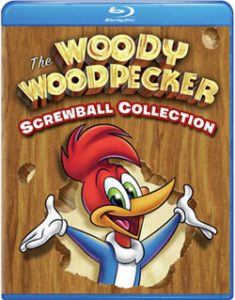 Woody Woodpecker at last on Blu-ray! To accompany this important release I would like to provide a guide to the often obscure actors heard as voices in this cartoon collection, presented in the same format as my earlier (and upcoming) pieces on Tex Avery’s MGM voice artists. First, some scene setting.
Woody Woodpecker at last on Blu-ray! To accompany this important release I would like to provide a guide to the often obscure actors heard as voices in this cartoon collection, presented in the same format as my earlier (and upcoming) pieces on Tex Avery’s MGM voice artists. First, some scene setting.
In late 1935, Walter Lantz was set up to produce cartoons independently for Universal release, still on the studio lot. But in 1940 Universal, teetering financially, cut off the advance weekly money they had been paying him for the previous four years. Lantz was now forced to raise money to produce cartoons as a complete independent. This arrangement lasted, with one hiccup as we shall see, until 1972. Crazy House, an Andy Panda entry, was the first cartoon under this new contract, made with loyal staff whose pay was deferred until three or four films were completed. The cartoons were to be strongly gag based in order to compete with other studios, with Alex Lovy now supervising and essentially co-directing with Lantz. Although he had enjoyed some success with Andy Panda what Lantz badly wanted was a standout star character to match the new brashness and zaniness of the increasingly popular cartoons made by Leon Schlesinger for Warner Bros. Luckily, Lantz’s new story man had just come from Schlesinger’s where he had been in on the development of two increasingly popular characters, Daffy Duck and the early version of Bugs Bunny. His name was Ben “Bugs” Hardaway and he was crucial in the creation of the character that made Lantz’s studio a big player at last. That character was Woody Woodpecker.
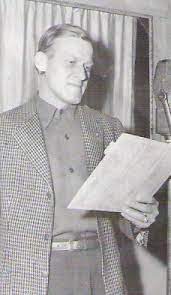
Bugs Hardaway
After two more years with Leon, Bugs Hardaway left for a job with Walter Lantz, whose long-time story man Victor McLeod had recently left. Hardaway wrote a couple of stories freelance, teaming with writer Lowell Elliott. After writing RECRUITING DAZE, Hardaway’s second story was KNOCK! KNOCK! which went into production just before he joined the Lantz staff in summer as head of the story department. Ostensibly another entry in the Andy Panda series, the show was decisively stolen by a garishly colored and grotesque woodpecker (suggested by Lantz) who heckled, annoyed and prodded Andy’s poor Dad and ran off with the picture. Lantz had his new star.
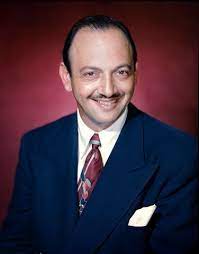 WOODY WOODPECKER (released July 7, 1941)
WOODY WOODPECKER (released July 7, 1941)
After receiving enthusiastic exhibitor notice in the Andy Panda cartoon KNOCK! KNOCK! in late 1940, the crazy Woodpecker was deemed strong enough a character to front his own series and after writing several other cartoons for Lantz, Hardaway teamed with gag man Jack Cosgriff for the official Woody series debut. For Woody’s voice, Hardaway was pleased to work with old Warner crony Mel Blanc, who was asked by Lantz to try something distinctive. Lantz recalled telling Blanc, “They make a very raucous sound.” Darrell Calker suggested a noise based on a bugle call and Hardaway in turn suggested a variation of the zany voice Blanc used for one of the formative Warner rabbit cartoons, HARE-UM SCARE-UM which Hardaway had co-directed. Mel then varied that cartoon’s annoying laugh to match a sillier musical giggle he had practised in high school “to test the echo in the school corridor.” It was five famous notes, with the fourth stressed, like “Ha-ha-ha-HA-ha!!!”
For this second appearance Blanc played him even more unhinged and was given a special song to sing called “Knock on Wood.” Mel also played the psychiatrist Dr. Horace N. Buggy (a prototypical Hardaway pun) and did the character saying, “You’re screwy!” Others heard were Danny Webb as the frog-voiced Owl, Margaret Hill as the female squirrel and bird, and Hardaway himself as the curmudgeon who yells, “Hey You…cut out that noise!”
THE SCREWDRIVER (released August 11, 1941)
Again gagged and written by Hardaway and Cosgriff, this third cartoon with the nutty Woodpecker finds him caught for speeding. Mel Blanc made Woody zanier than ever, and also added the vocal sound of the car engine and the voice of the very dopey traffic cop. The crazy pair were the very essence of Hardaway’s earthy and, some would say, crude approach to comedy.

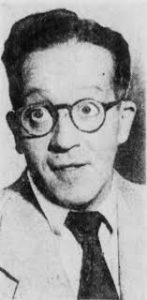
Danny Webb
This was the final cartoon featuring Mel Blanc, who had recorded some lines just before his exclusive deal with Schlesinger Productions took effect in the spring of 1941 (although his opening “Guess who??” was re-used for years afterward, and his Woody laugh was re-used until 1949). When more work was done on the track another person did some of Woody’s lines, and it is uncertain who. Bob Clampett believed it was Danny Webb, who had been doing many voices for Lantz since 1938. It could be, because the hungry Kitty Cat with the froggy voice appears to be Webb (and typical of Lantz’s tendency to cut costs, the same froggy sound emerges from a moose, obviously done by the same voice person). Another news item claimed the “Willie” Woodpecker was to be done by actor Bob Cummings’ stand-in, Ed Regan. This is unproven. And Webb, if it was him, was soon drafted and would be unavailable from this point. Lantz was getting desperate to find a permanent replacement and he remembered a young actor who’d recently done some Universal cartoons. Note also that the female voices in this cartoon were done by radio girls Marge Tarlton and Margaret McKay.

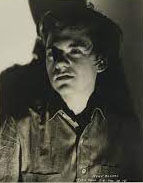 THE HOLLYWOOD MATADOR (released Feb 9, 1942)
THE HOLLYWOOD MATADOR (released Feb 9, 1942)
After Blanc became exclusive to Leon Schlesinger Lantz finally cast Kent Rogers who had been doing small roles in several of his cartoons. Rogers gave to Woody a tough wise-guy approach, at times like his Leo Gorcey impression. It didn’t really matter because, once the lines were recorded, it was mechanically sped up to match Blanc’s version of the character. Rogers also gives the bull his voice, while Bugs Hardaway, who co-wrote with Lowell Elliott, does the elevator operator and the announcer. Director Paul Smith, at the time an animator, once said that Hardaway “sat in on the recording sessions and often contributed odd lines. Laughs and vocal sounds.”
ACE IN THE HOLE (released June 22, 1942)
Hardaway and Milt Schaffer are teamed at this point and end up writing the stories for virtually every Lantz cartoon over the next four years. Hardaway concentrated on the endless cornball gags while ex-Disney man Schaffer helped structure the stories and drew the boards. Alex Lovy became the sole director as Lantz relinquished his directorial contributions in order to concentrate more on his producer role as the studio became busier with training films for the war effort.
By this cartoon Kent Rogers has mastered his version of Woody, and he also does the Bulldog Sergeant as an imitation of Harold Peary’s Great Gildersleeve radio character. “Gildy” was one of the most distinctive voices on the air, heard every week from 1941-58, and was a perfect voice for a cartoon role. Rogers did this voice at MGM too, in Avery’s ONE HAM’S FAMILY, and mimic Dave Barry was among others who did the voice…even Tex Avery did a Gildersleeve take-off in his WB spot gagger HOLIDAY HIGHLIGHTS as the College Dean.

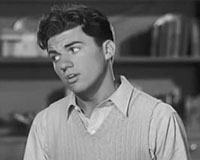 THE LOAN STRANGER (released October 19, 1942)
THE LOAN STRANGER (released October 19, 1942)
Kent Rogers continues as Woody here in a cartoon that mocks the famous acting legend John Barrymore’s pompous stage manner for the loan shark Fox named Hudson C. Dann (another typical Hardaway pun). Barrymore was at the time a weekly regular on Rudy Vallee’s radio show and was happily satirizing his own image as a once-great now in booze-addled dotage. Kent does the Barrymore fox’s voice (rather loosely it must be said – at Lantz gags mattered much more than accurate mimicry), and also has him doing a good Red Skelton imitation for Woody, while the cartoon even features Mel Blanc by proxy: a soundtrack lift has Woody reprising the “Knock on Wood” opening song from his first starring cartoon of two years earlier.
THE SCREWBALL (released February 15, 1943)
This was the final Kent Rogers appearance as Woody. Like Danny Webb before him, Rogers was drafted and would soon be off to Florida for flight training. His multi-voice skills were always exceptional for such a young man and he gets a final chance to shine in a Woody short for Lantz, whose budget here was typically low. For this cartoon he was happy to pay just one actor, so Kent does not only Woody but every other voice we hear at the baseball game: the cop (his fine Gildersleeve voice again!), the “Ouches,” the man in a seat, a vendor, a ballplayer, a Red Skelton voice for the batter, a worm, the Umpire and the catcher. Whew!!
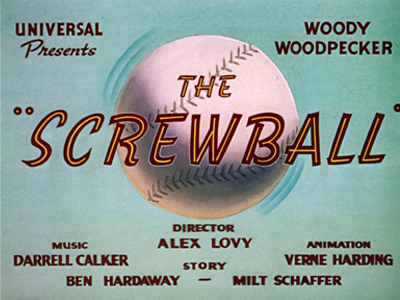
RATION BORED (released July 26, 1943) Working title: Gas Bandit
Lantz’s regular director Alex Lovy had entered the navy in 1942 and for this Woody cartoon story man Milt Schaffer and the gifted animator Emery Hawkins were assigned the job of co-directing while Lantz awaited the arrival of new director Jimmy Culhane (Schaffer and Hawkins previously co-helmed THE EGG CRACKER SUITE, an Easter Swing Symphony which revived the retired Oswald Rabbit for one cartoon).
Still experimenting with his star character’s voice, Lantz hired his other regular young radio mimic Dick Nelson as Woody for this cartoon, which satirises wartime gas rationing. The versatile Nelson also adds the voices of the gas station guy and the policeman whose car Woody tries to siphon.
THE BARBER OF SEVILLE (released April 10, 1944)
The experienced and restlessly creative animator James “Shamus” Culhane came on board at Lantz in 1942 as the next director. The cartoons, which to this point had been corny but often enjoyable gag fests, had lately been approaching the quality of top studios like Disney and Warners while still lacking true greatness. Now, with the arrival of the singularly gifted Culhane, Lantz’s films took a quantum leap and became truly memorable examples of the 1940s cartoon in a range of areas like design, music, animation and sheer pace. This Woody entry was his fifth cartoon for Lantz and his first with the crazy bird.
Dick Nelson wasn’t able to commit full-time to Woody’s voice as he had radio commitments including a potential job in New York, although he did three character lines for this cartoon: the Indian, the Greek and the Henry Aldrich voice yelling, “Coming, Mother!”
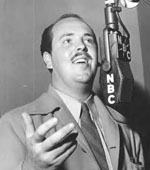
Lee Sweetland
The icing on the cake with this entry was the idea of hiring Lee Sweetland, a fine baritone session singer, to do the operatic section as Woody goes crazy in the barber shop. Sweetland’s wonderful voice is sped up to match Woody’s pitch as he warbles Rossini’s famous “Largo al Factotum” while Culhane’s ingenious direction with its insanely quick cuts produces an amazing climax to a unique cartoon.
THE BEACH NUT (released October 16, 1944)
Culhane was always interested in trying new voices, especially now that supporting characters would have to contrast with the deliberately monotone sing-song of Hardaway’s trickster Woody voice. For a new nemesis the story team came up with a Walrus character to be named Willie, soon changed to Wally. Danish pianist-comedian Victor Borge (at the time a regular on Bing Crosby’s Kraft radio show) was approached to do the voice, but a deal couldn’t be worked out (code for he was too expensive). In Borge’s place came an excellent actor from radio, Jack Mather. Mather, who had been doing voices for SPEAKING OF ANIMALS for Paramount, was one of those radio specialists who did a range of authentic nationals and he auditioned as Wally in an amusing stage Swedish dialect. It is also Mather doubling as the opening narrator. Lantz’s musical director Darrell Calker re-hired the baritone Lee Sweetland to record song material for three more Woody’s following the hilarious results in THE BARBER OF SEVILLE. In this cartoon it’s Wally who sings “My Bonnie Lies Over the Ocean” as dubbed by Sweetland.
SKI FOR TWO (released November 13, 1944)
Jack Mather returns as Wally Walrus, ski lodge owner, and Hardaway does Woody while Lee Sweetland sings for the Woodpecker, trilling “Merrily On We Go.” A dialog page in the Lantz Archives at UCLA has a note in Walter’s hand suggesting “at the end of the song have Sweetland sing Woody’s laugh.”
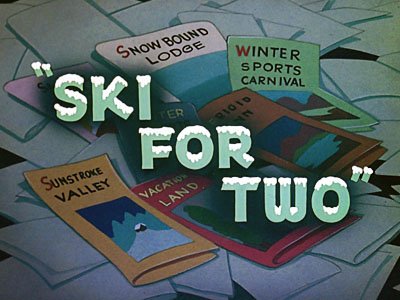
CHEW-CHEW BABY (released February 5, 1945)
Mather again shows his fine acting chops as the lovelorn Wally Walrus. Pining after a girl, he is sadly deluded by Woody in drag. His performance as the walrus is both funny and pathetic. Sweetland does one more singing job as Woody doing “Clementine,” and the “My Bonnie” song is reprised too.
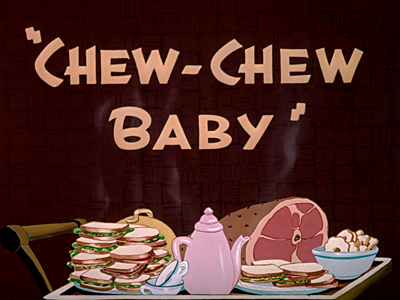
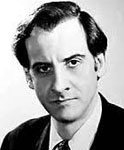
Hans Conreid
Shamus Culhane, now into his 15th Lantz cartoon, sought another fresh voice to contrast with Hardaway’s Woody and got the singular Hans Conried, always a great choice for cartoon acting. Hans had just done opening narration for the Swing Symphony SLIPHORN KING OF POLAROO for new director Dick Lundy, hired by Lantz to ease Culhane’s burden.
Here Hans, in a change from his usual fruity bombast, is directed in a softer approach for the oddball taxidermist cat and he ends up sounding for all the world like the young Victor Buono would sound twenty years later.
THE LOOSE NUT (released December 17, 1945)
Woody, playing golf, menaces a burly cement-laying workman whose tough voice is provided by still another Culhane choice, Will Wright. This gaunt, familiar actor with a resonantly edgy voice played a range of character roles in movies of the 1940s, from old codgers to judges to nasty villains. Cartoon buffs know his voice from his beautifully acted role as Friend Owl in Disney’s Bambi.
THE RECKLESS DRIVER (released August 26, 1946)
To demonstrate how much time elapsed between the start of production of a Lantz cartoon and its final release, this entry’s dialogue was recorded in February 1945 and the finished cartoon wound up in theatres a year and a half later. Will Wright returned to have a go at Wally with a tough guy voice but no Swedish accent. However it seemed inconsistent to audiences and the Swede dialect was reinstated for later appearances by the walrus. (When Wally smashes his own hand he temporarily gains a second voice, as Lantz decided to cut in a piece of soundtrack from WOODY DINES OUT where Hans Conried is doing his take on Red Skelton’s radio brat Junior, with Wally agonizingly yelling, “Ooooohh, I hurt my wittle hand…”)
FAIR WEATHER FIENDS (released November 18, 1946)
This was the final Woody cartoon and indeed the final Lantz cartoon by the talented Shamus Culhane who was let go at war’s end by Lantz who didn’t have enough work for two directors. Culhane, who eventually wanted to work for himself, left with no hard feelings. He had had enough of Woody not to mention Hardaway (these two vastly different creative types tolerated each other but were never boon companions). For this cartoon the versatile Will Wright came up with a perfect character voice for Woody’s Wolf companion…the two are shipwrecked, and neither one trusts the other. Will Wright gives a great reading to the Wolf’s phony bonhomie, referring to Woody as “My old Palsy-Walsy.”

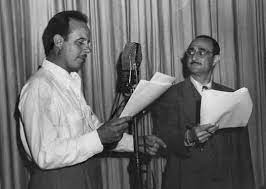
Jack Mather and Harry Lang
With Culhane’s departure Dick Lundy is now the only full-time Lantz director. This take on the fairy tale, co-written by Hardaway with Disney story veteran Webb Smith, features Harry Lang who had done various fine characters for Lantz in the Swing Symphonies, especially THE GREATEST MAN IN SIAM where he was every voice. Here Lang does Buck Beaver the con artist bean seller, with Jack Mather as the Giant. Interestingly Lang and Mather worked together on the Speaking of Animals shorts, while on radio Mather played the famous Cisco Kid with Lang supporting him every week for seven years in the comic relief role of Pancho. (When Lang had a heart attack Mel Blanc filled in for him as Pancho, continuing in the role after Lang’s passing in 1953. See how small the radio and cartoon voice industry was back then?)
At this point Lantz and Universal-International had a falling out and Lantz contracted to release a season of cartoons through United Artists.
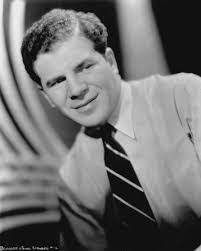
Lionel Stander
The distinctively flat voiced actor Lionel Stander was having difficulty getting work – he was a self-avowed left winger and the HUAC people had come after him in the early round of hunting down so-called Hollywood subversives. His ex-wife was working for Lantz and Walter decided to employ Stander to do the great Buzz Buzzard voice. (Culhane had already used Stander for the 1944 Andy Panda cartoon Fish Fry). Lantz’s recall of voice artists’ names wasn’t too hot when it came to various actors from back in the 1930s and 40s, but in 1988 he was on a cartoon panel in his old age, alongside his wife Gracie and Daws Butler, and when a question about older cartoons came up he proudly chimed in, “I used Lionel Stander as Buzz Buzzard!!” It got a round of applause because by then Stander, finally back working in Hollywood, was well known to a younger audience from his regular role of Max on TV’s crime series HART TO HART. Note too, that this cartoon features the “Woody Woodpecker” hit parade song as sung by vocalists Gloria Wood and Harry Babbitt.

Grace Stafford
Lionel Stander returns to voice villainous Buzz Buzzard in this excellent Western parody which shows the influence of Tex Avery’s story collaborator Heck Allen, who co-wrote this and the previous cartoon with Bugs Hardaway. Pinto Colvig makes a return to the Lantz studio as three voices: the gruff Sheriff, the Devil and Wild Bill, while Gracie Lantz plays the Angel, and Hardaway is, as usual, voicing Woody. The call sheet for this cartoon survived the ravages of time, and shows that Heck Allen and Jack Mather added some ad libs to the crowd sounds in this cartoon….with the advent of tape Lantz was able to record dialogue for two or more titles in one session, so on the day this cartoon’s voice track was recorded he also taped dialogue for the Andy Panda cartoon DOG TAX DODGERS which had Jack Mather as Wally Walrus, dog inspector. Hence Mather’s stepping in to add audio atmosphere to the Woody western.
This was the third last of the United Artists cartoons after which Lantz would close up shop for a short time. After a decade of Lantz cartoons, Hardaway and various other staffers did not return in the 1950s.
THE WOODY WOODPECKER POLKA (released October 29, 1951)
After Lantz returned to Universal he was on a very tight budget for this first series, and he self-directed them all using some stories that had been written before the UA deal folded. He had already completed five cartoons with no dialogue, just pantomime gags, and was finally able to afford limited outside talent, in this case a vocal group called The Starlighters to sing the title tune. The soundtrack used Gracie Lantz laughing for Woody and Mel Blanc’s old “Guess who?” but some of these were re-dubbed by Gracie for the TV prints used on the later Woody Woodpecker Show.
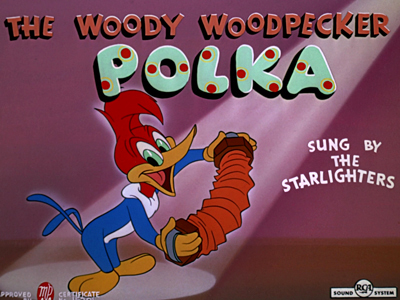
BORN TO PECK (released February 25, 1952)
The eighth of Lantz’s voice-less Woody cartoons depicts the bird’s life from egg to seniority. The soundtrack has Gracie Lantz supplying sped gibberish sounds for the parents and the ants, as well as Woody’s newly recorded laugh. In a couple more cartoons she would become Woody’s longest-running voice.
The TV soundtrack, which is the version on this disc, contains Gracie doing the narration.
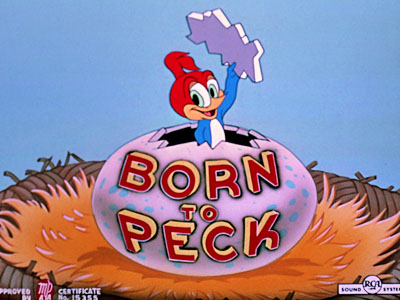
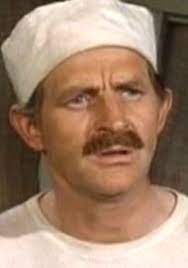
Dal McKennon, in the early 1950s
The first nine of Lantz’s low-budget cartoons had, happily, performed well at the box office and Universal, now able to see a popular ongoing series, increased the cartoon studio’s production budget. Don Patterson, a talented ex-Disney animator became Lantz’s first director under this new Universal contract. He and Lantz provided this spoof sci-fi story. Many voices were now provided by character actor Dal McKennon who had recently started working for Lantz. A capable utility voice, he would remain with the Lantz studio for the next twenty years. Here McKennon does the Astronomer, as well as the Walter Winchell take-off and the announcer. Gracie was now settling in to her long running version of Woody’s voice.
UNDER THE COUNTER SPY (released May 10, 1954)
When cartoon writer Homer Brightman left Disney after 15 years in 1950 he freelanced for years on both comic books and at various cartoon studios including many years doing stories for Lantz cartoons, starting with THE GREAT WHO-DOOD-IT. Here he and director Don Patterson join in the new trend of spoofing early TV shows. The famous cop show DRAGNET had already been parodied on records by Stan Freberg and Spike Jones. Lantz voice veteran Dick Nelson recorded all the voices for this take-off: the opening voice, the cop Thursday (sending up Jack Webb’s underplayed character of Joe Friday), his partner Al, the phone voice, the hung over Woody’s conscience, and a TV newsman. As this cartoon neared completion, a gag was added satirizing Jack Webb’s closing production logo of a hand hammering a stamp of the company name Mark VII. Patterson needed a loud “Ouch!!!” and rather than get Dick Nelson back in, they asked Daws Butler, who was booked that day to do CONVICT CONCERTO, to add the yell.
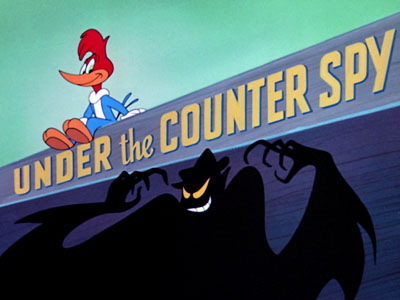
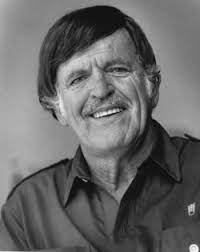
Bob Johnson
Dal McKennon’s old friend, a fellow Oregon performer named Bob Johnson relocated to Hollywood and within two days, thanks to McKennon, he had a Lantz job. Johnson was a trained operatic baritone with a resonant voice that you will all remember from TV’s Mission:Impossible where he was the much-mimicked opening voice (“this tape will self-destruct in five seconds”). In this Woody cartoon Johnson did voices for the Narrator and the Guide, with Gracie as Woody and the giggling woman.
THE BIRD WHO CAME TO DINNER (released March 7, 1961)
The final cartoon in this collection is a competent but routine Woody of the later period, with old hand Paul J. Smith directing a Brightman story about Woody mooching a meal.
The voices are Gracie doubling as a rich woman and Woody, and Dal McKennon doing the Toy Salesman and Reginald. Since 1958, all Lantz cartoons had credits naming the voice artists. In this area Walter was a true pioneer, as screen credits didn’t appear elsewhere until 1962 and beyond. It was why Walter was spoken of with respect by June Foray, Daws Butler and Paul Frees.
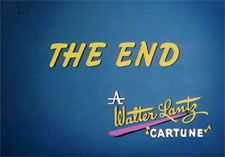
Acknowledgments: I would like to thank Brigitte Kueppers who in 1996 and 1998 was curator of Special Collections at UCLA’s Charles E. Young Research Library and who guided me through the Walter Lantz Collection. I am grateful also for the fine writing on various aspects of Lantz history by animation scholars Tom Klein, Joe Adamson and Mike Barrier. My research associate, the late Hames Ware, and I started work on this mostly undocumented area of cartoon history way back in the 1980s. I am still discovering new information and am always happy to note corrections. Thanks too to the late Daws Butler, Paul Frees, June Foray and Dal McKennon for talking about Lantz. And to Jerry Beck for this fine forum for cartoon research.


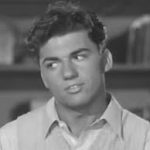
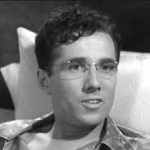
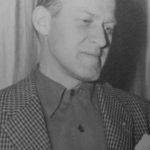
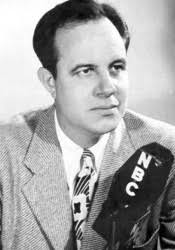
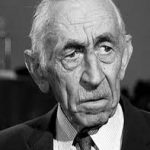
 Keith Scott is a voice actor, impressionist and animation historian. Scott provided the voice for Bullwinkle J. Moose in the 2000 motion picture The Adventures of Rocky and Bullwinkle (for which he had been specially flown to the United States several times) and did the voice of the narrator in George of the Jungle and George of the Jungle 2. An expert on the history of Jay Ward Productions, Keith authored the book The Moose That Roared: The Story of Jay Ward, Bill Scott, a Flying Squirrel, and a Talking Moose (St. Martin’s Press, 2000).
Keith Scott is a voice actor, impressionist and animation historian. Scott provided the voice for Bullwinkle J. Moose in the 2000 motion picture The Adventures of Rocky and Bullwinkle (for which he had been specially flown to the United States several times) and did the voice of the narrator in George of the Jungle and George of the Jungle 2. An expert on the history of Jay Ward Productions, Keith authored the book The Moose That Roared: The Story of Jay Ward, Bill Scott, a Flying Squirrel, and a Talking Moose (St. Martin’s Press, 2000).



























































I would love to see a release of the original Woody Woodpecker Show which featured Walter Lantz and Woody as co-hosts. This show was one of the delights of my childhood. One of the earliest examples of showing not just the end product, but part of the creative process that went into the making of cartoons. Lantz was a very genial presence on TV.
I also would like to see the later Woody cartoons that continued to be made into the early 70’s. These have become extremely rare of late, though for years they were regularly shown on TV.
Mel Blanc also voiced Woody on the Capitol record albums released in the late 40’s and early 50’s. Woody Woodpecker’s Talent Show is a true classic among cartoon albums.
Great post, as always. Thanks!
I know this post is all about the voice artists in these Woody cartoons, but I’d like to know more about storyman Jack Cosgriff, who also did some great cartoons with Tex Avery at MGM. I know he wound up his career at Format Films working on the Alvin Show, and I believe he also did some work in comic books as well, but I haven’t come across any information on his background or personal life
Thanks for all this fascinating information, and especially for recognising the work of Kent Rogers, who in his brief career proved himself to be a voice actor of exceptional talent.
Jack Cosgriff also storied some of the better Screen Gems/COLUMBIA cartoons
Hi..vcery much enjoyed it..Jack Mather also was in MGM, WB and Disney cartoons for a time in the war era…
Great job on this fascinating article, Keith. I did know Ben didn’t do Woody’s voice till “The Barber of Seville”.
While I like the early Woody Woodpecker films I really like the SWING SYMPHONIES.
I’m SO waiting Keith Scott’s much anticipated book about classic cartoons voice actors, I’d love credits too. These articles are a terrific delight. Thanks a lot for all!
My book about the voice artists of the 1930-60 period where they were virtually all uncredited) is getting closer to completion. It will be a study mainly of the West Coast talent (chapters on Warner, MGM, Screen Gems, Lantz, UPA, Disney), although there will be a Fleischer -Famous chapter too. The NY voices of Terry and Van Beuren have been all but impossible to find so will have to wait for a revised edition. And there will be credits in voice-centric filmographies, as complete as I could make them with the lack of documents.
Hey, do what you can.
Perhaps your book,
Once read by others,
Will give them a look,
Some of whom
Might have some insights
And may deliver to you
Some pint-sized bites
That will allow you to piece
Together your list
That might not have existed
If not for this.
Can’t wait, one of the animation related books I’m really waiting for.
May I suggest complete filmographies of the studios instead than filmographies of the single voice actors? This way we’ll have the list of cartoon voices for each cartoon of every studio.
I really hope it’ll come out soon and thanks for the titanic work!
That’s what the book WILL have, as you say…chronological studio voice-ographies, not ones for actors. Most studio voice information for the period 1930-36 is patchy, but I will be documenting what is known. By 1937 the information becomes a little more comprehensive with each year, and it will cover 1930-60 (although MGM will cover the 60s Jones Tom & Jerry era, Disney will be covered to the year of Walt’s death 1966, WB to 1969, Lantz to 1972, plus Columbia and UPA, as well as a listing of the limited info we have on Fleischer 1929-42). Plus the studios will ahve actual chapters discussing the voices used…kind of like expanded versions of these Cartoon Research articles. But it is purely a study of the Golden Age, when voices were not given screen credit, except of course in the case of Mel Blanc.
Thank you very much. Also, can you do one on the Warner voices, especially Robert McKimson’s – like Jim Backus, etc.
Thank you.. and David, on Woody, AGREED!
Steve
Keith,
Please let us know when your book is published!
Jim
A Keith Scott column is always appreciated, informative and entertaining and I hope we will see many more. Thanks for all your hard work documenting this information that is slowly getting lost and more difficult to confirm. There are so many bad books out there about animation voices, I hope that one day you will write a better one or a series of books.
This also gives me a chance to promote another hard working animation researcher, Harry McCracken who has written an exhaustively researched article on the Jay Ward Rocky and Bullwinkle stature on Sunset in Hollywood, finding even more material than you covered in your outstanding book on Jay Ward that I passionately recommend to others. https://harrymccracken.com/blog/2021/09/18/bullwinkle-statue/
Who voiced Woody in “The Dizzy Acrobat” Rogers or Nelson?
That was Kent Rogers (the Leo Gorcey quality is there).
I assume Danny Webb was also Woody Woodpecker at the very end of Pantry Panic? (In which his voice suddenly depitches)
I have no proof and I don’t like guesswork, but it is likely. (Most of the voices I attribute have been found with documentation to back up the discoveries.)
Danny Webb was also the host/performer of two local NYC based kids tv shows in the 1940’s and 50’s”Comics On Parade”/”The Danny Webb Show” and “Six Gun Playhouse”..which were seen on WPIX TV Ch.11 in NYC.
Dallas McKennon was also the host/performer of a local Los Angeles,Cal. based kids tv show”Space Funnies!”/”The Captain Jet Show”..which was seen on KNXT(KCBS)TV Ch.2 in the early 1950’s. “Captain Jet”was spoofed on one “Woody Woodpecker”cartoon “Woodpecker From Mars”.
Thanks Kevin. I knew about McKennon being caricatured, but your Danny Webb info about Six Gun Playhouse is new info. I appreciate it!
Outstanding article, Keith! Your book will answer many of my 1000+ questions about radio and animation voice artists – and which cartoon directors/writers in addition to Tex Avery, Tedd Pierce, Cal Howard and John McLeish doubled as actors. If anything in the voice acting world compares to the tragic losses to the music world of jazz trumpet genius Clifford Brown and rock guitar guru Jimi Hendrix, that would be Kent Rogers’ untimely death in a WW2 training accident.
It seems from your evidence that Kent Rogers invented the Woody “sadistic” laugh, a sort of machine-gun chortle. There’s a version of it toward the end of “Loan Stranger”, and an even meaner take (Woody delighting in tormenting his foe) pops up in lots of cartoons after Rogers left, such as “Who’s Cookin’ Who”, in what sounds like an older borrowed clip.
It came in handy, in an era when Woody’s personality leaned on the nasty side.
True it was re-used. Kent did that chortle at MGM in Tex Avery’s WHO KILLED WHO? and it was re-used there too.
Loved the old wacky Woody shorts no matter who voiced him. Hated it when he became a boring, homogenized character in the Grace Stafford era. I can’t even watch those later toons.
I have to totally agree. Loved the early Woody Cartoons of the 40s, and especially the early 40s. Even as a kid in the early 70s, noticed the later Woody toons were not as good.
Does anyone who voiced the male birds in “Pantry Panic”? They sound like Dick Nelson, I think.
I wonder when a second volume of the “Screwball Collection” is gonna get released (and possibly more if it’s sucessful)…